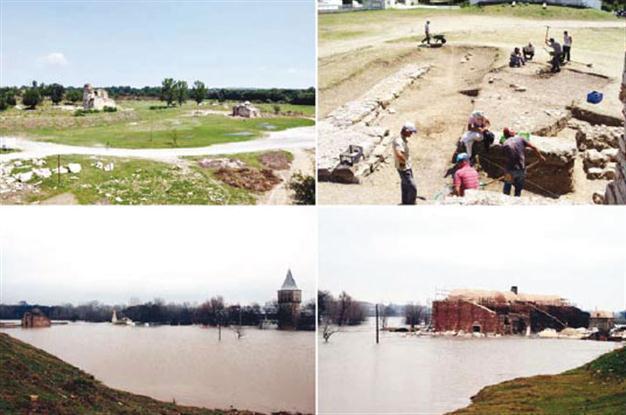Ottoman palace suffers from flooding, neglect
ISTANBUL - Anatolia News Agency

Head of the excavatons in the Edirne Palace, Mustafa Özer says they have talks with officials about their problems but cannot get any result. ‘We expect support from relevant institutions,’ he says. AA photos
Restoration works at
Edirne Palace continue despite being plagued by continuing floods in the northwestern province of Edirne. Only a small part of the palace survives today, which once was comprised of 100 structures and was the largest palace in the
Ottoman Empire after Topkapı Palace.
“We try to take the necessary measures and preserve the architectural ruins that we have unearthed. We take small findings to the museum,” Edirne Palace excavation head and Bahçeşehir University Associate Professor Mustafa Özer said.
“Damage in the Turkish bath and kitchen sections is not too serious, but the buildings cannot be used since they are under water,” he said.
Özer said they have been restoring the palace since 2009. He said Bulgaria opened dam shutters during a period of heavy rains and as a result floods damaged agricultural fields as well as historical structures.
Edirne Palace included 100 structures and occupied a larger area than Topkapı Palace, Özer said, adding that Topkapı Palace was a more complex structure. The structures served as ammunition depots during the Ottoman-Russian War and were set on fire so enemies could not find them. Most of them collapsed, he said.
10 structures survive
“Actually, we ruined our structures with our own hands. There are 10 structures from the palace that still survive. Moreover, two military barracks have been built on the historic palace,” he said.
Özer said the Public Waterworks Administration had built a floodwall to protect Edirne from floods and the floodwall also passed through the palace. But the construction of the floodwall had heavily damaged the palace.
“The floodwall was built to prevent floods, but an important part of the palace was destroyed,” he said, adding that the palace was damaged by floods since it was located close to the Tunca river. “There is a summer place on the coast of the river and the first floor is flooded,” he said. Özer said because of flooding and clay, they were back to where they had started in the restoration works project.
“There is also the Balkan martyrdom in the palace – it is being damaged too. The palace is the place where the Balkan Wars occurred,” he said, adding that it had historical value as well as archaeological value.
River bed should be cleaned Özer said the problem could not be solved by the Culture and Tourism Ministry alone and other ministries should intervene. A dam should be constructed on the coast of the Tunca river, he said.
“There is a dam construction project on the agenda. It has been discussed for years but cannot be resolved. If the river bed is cleaned, it will be partially useful,” he said.
There once was a 5- to 6-meter wall surrounding the palace, which can be seen in photos and old documents, Özer said, adding that if a similar dam were constructed, the palace could be saved from floods to some extent. “Also, the river bed should be cleaned as soon as possible. We expect support from all relevant institutions,” he added.
Özer also said Edirne’s famous Kırkpınar Oil Wrestling competitions were organized in the area of the palace, causing serious problems. “We have had talks about such problems, but we cannot get any results,” he said, adding that the palace garden was used as a parking lot during the competitions.
Özer also said there was a security problem. “We cannot protect the palace, and our restoration work is sometimes destroyed. We built gates, but they were stolen,” he said.
